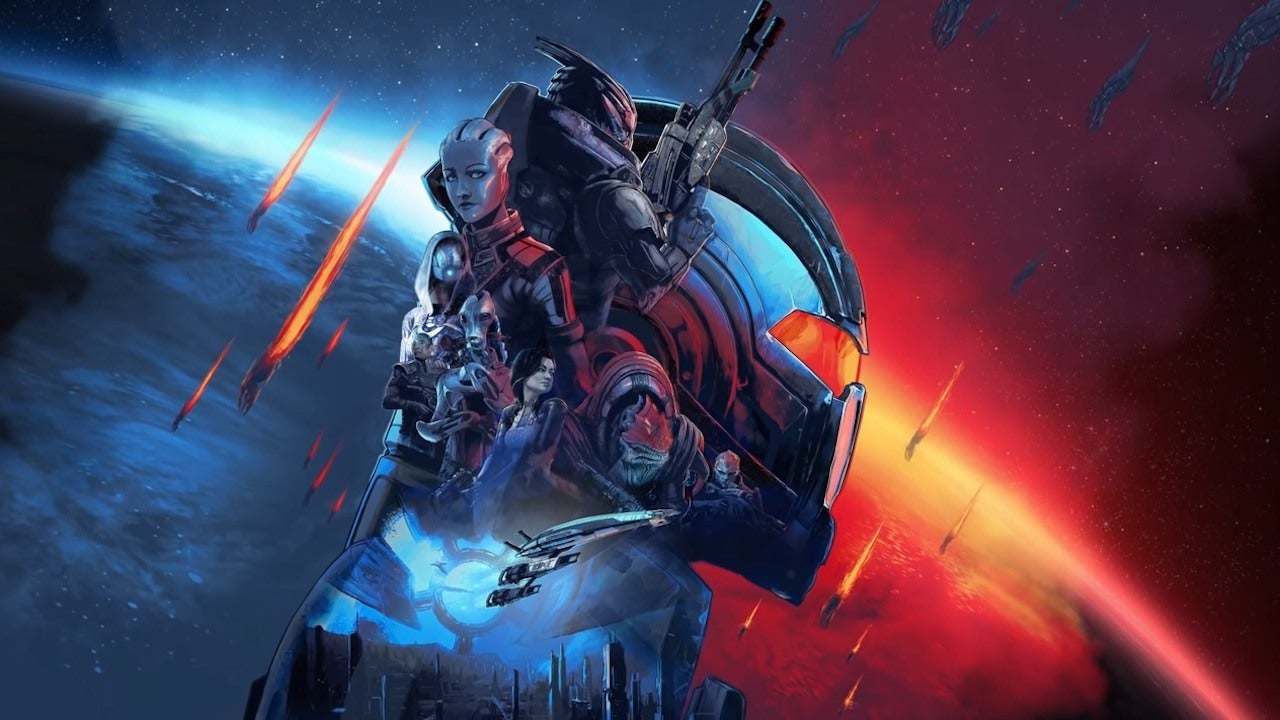Mass Effect is the game that should have saved the CRPG, in all honesty. It didn’t, but that wasn’t its fault.
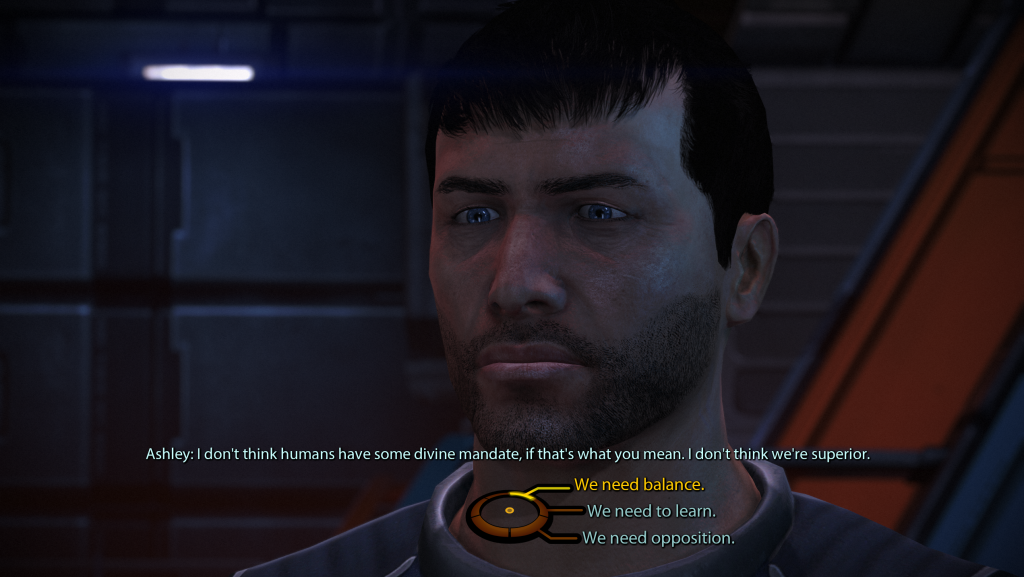
Originally released in 2007, the first entry into the iconic and now semi-defunct hybrid shooter/CRPG series was much, much heavier on the latter elements than the former. It was the next big project coming out of BioWare after Star Wars: Knights of the Old Republic in 2003 and Jade Empire in 2005 — the former being much better remembered than the latter, and the latter perhaps being a later retrospective entry in this space if I really want to punish myself by getting it running on a modern machine and then again by actually playing it — both of which were more traditional third-person action adventure games in the confines of the BioWare space once ported to three dimensions. Mass Effect is the second game in this lineage from this publisher not to lean to an unseemly degree on the Dungeons & Dragons 3.5 Edition roleplaying system (specifically a version of the d20 Modern rules) after Jade Empire, but in addition to being a game made by a Western studio fetishizing genericizing Chinese and pan-Asian cultures — with all the problems that entails — the title just didn’t play very well. It tried to be a character action game, whereas Mass Effect blended its CRPG roots with a much more stable and popular genre that was popularizing itself in the late Aughts: the cover shooter.
The original tentative forays into cover shooter-ing are…haphazard, let’s say. The first Gears of War had only released the previous November to Mass Effect, while the game was already well into development, and while Gears isn’t the first cover shooter to ever exist — and game trends in dev are well-known before the release of massive AAA console generation-defining projects like the original Gears — the first installment hardly leans into it, as anyone who has played either the original 2007 or the Legendary Edition version can attest. The best thing that the Legendary Edition update has done is made it so that you can play Mass Effect with a controller, something that there was no standardized, expected programming for when the original PC version was released and which was never patched in on any version of the game officially after launch. I should know; I’ve replayed Mass Effect once every 2-3 years since it came out, and I’ve checked every time. Fan-made patches allowed you to kludge controller button mapping onto it like a joystick, but that was about it. The game was made to play on the controllers of the console generation of the time — the XBox 360 and the PlayStation 3 — and it was incredibly clunky when played elsewise. Not as bad as Mass Effect 2 would be, of course, but we’re not talking about that game yet.
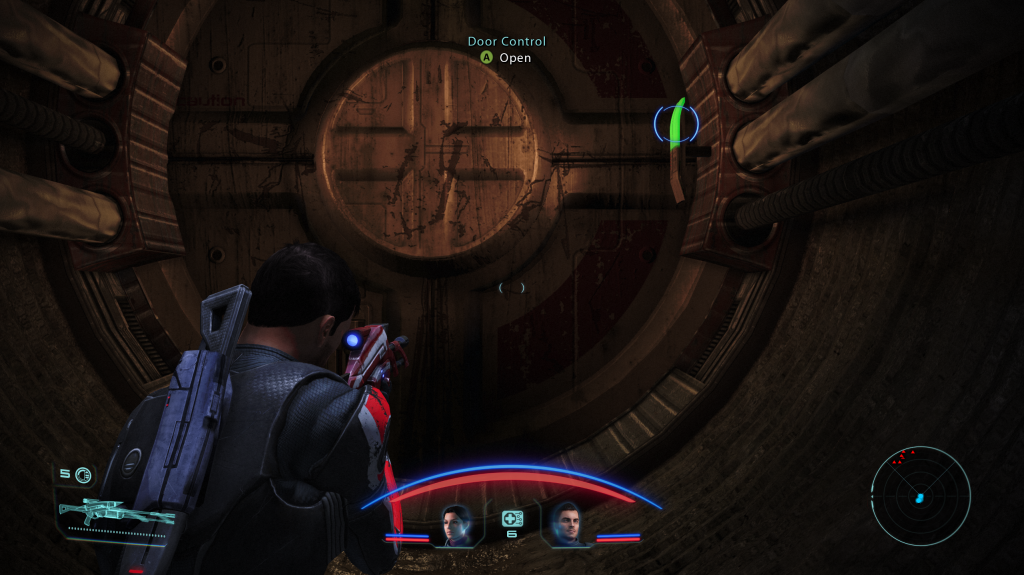
There are a lot of rough systems here; things that the later games would rightly iterate on but that are silly holdovers from how CRPGs used to be. If you’ve played Mass Effect, your mind will immediately go to the inventory system, as it should. There are a lot of other retro (or, less kindly, obsolete) mechanics to the 2021 eye, however: the grenade system, which was a lot like hucking a mini-frisbee and was on the controller bound to X/Square, which would otherwise be your reload key. The overheat system for guns, where there is in fact no reload system whatsoever but instead a game of chicken you play with your weapon where you try to fire it as fast as possible but not so fast it becomes unusable for five to seven seconds. There is a fully-modelled physics engine that mainly exists to flatter biotic users (the space wizards of the Mass Effect setting) and turn them into wonky, fragile, but ungodly-powerful combatants in the right circumstances. This last concession in particular is among the most old-generation, legacy CRPG design influences — the idea that if you know where the edge cases are and you know how the powers work, it is in fact good design to let you mercilessly stomp all over a combat encounter. On occasion in Mass Effect the computer will turn this against you — there’s a particularly nasty fight against five biotic spellcasters on a random frigate sidequest that on high difficulties has them all bum rush you, spam the biotic Slam that knocks your party off your feet, and execute you while they have you stunlocked — but usually and expectedly it redounds to the benefit of the discerning player-character.
Most of this stuff remains in the game unchanged in the Legendary Edition remaster. BioWare was up-front about this: This new package is mainly about getting the games with all their various DLC in one place with one file framework so that importing your save games between them is no longer a mess. There’s a couple bug fixes here and there, a couple quality-of-life improvements — failing the decryption minigame in Mass Effect no longer permanently locks you out of the container in question, for instance — and that’s about it, mechanically. In fact, most of the bugs related to actual gameplay as opposed to meta-progress and importation are still in there; you can still exploit the monkey on that one planet for infinite Paragon points, that one Turian in the Noveria bar for infinite Paragon or Renegade points, and you can still lock yourself out of the Mako by trying to enter a structure or otherwise press A or something while exiting the vehicle (a quick save and reload fixes this one). The one thing that has been updated is the graphics, and that up-res and application of modern shaders and lighting is most noticeable in Mass Effect as opposed to its two sequels.
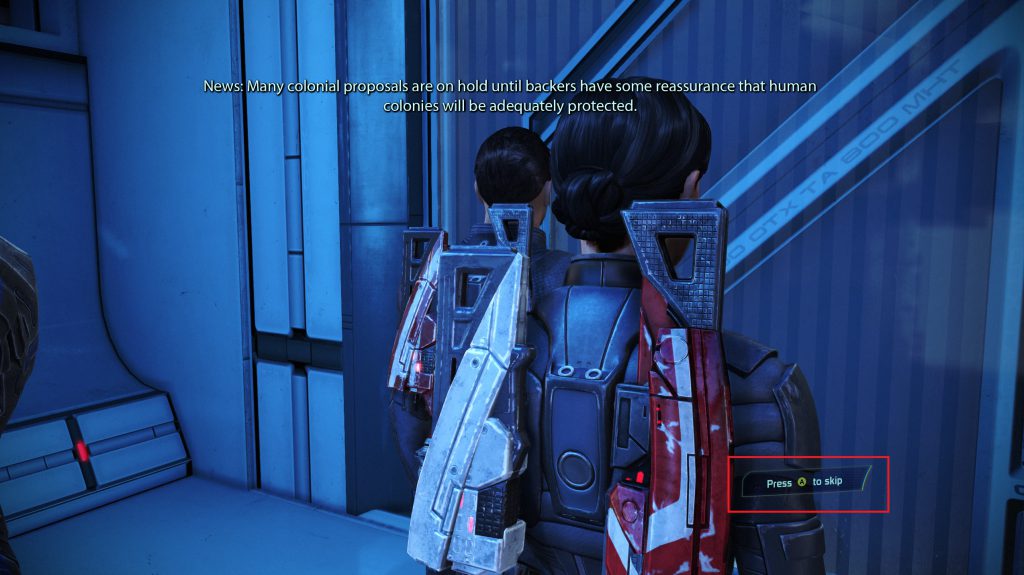
It looks good! The game looks good. You can go elsewhere for the really detailed rundown on the aesthetic changes; they’re more obvious in motion anyway. But the main takeaway is that they brought Mass Effect more in line with what they were doing in the later two games, which means a huge change to the lighting engine and how some textures work. There’s a bit more lens flare, sure, but lens flare on a planet’s sun or a Reaper’s red eye is one of the Mass Effect series’ chief stylistic choices. It’s as much part of the cultural moment this series was made in as the cinematic dichotomy between blue and orange (this game is blue; Mass Effect 2 is orange; Mass Effect 3 is a darker blue). One of the side-effects of the game’s increased resolution and texture fidelity is that everyone just looks grimier; you can see everyone’s pores, or their alien-equivalent, so much better (even Gunnery Sergeant Ashley Williams’s, who is the crewmember with her face most consistently on). Captain Anderson, played by and visually based on the incomparable Keith David, has a mountain range of a face. It’s almost a bit much, and it does remind you that the basis for these graphics are 2007 rigs, 2007 meshes, and 2007 textures. And as far as the animations go, if you haven’t played these games in a while you might find more in common with Mass Effect: Andromeda than you remember. That’ll be true through Mass Effect 3.
As for things that haven’t changed: Mass Effect remains the gold standard for building a new IP through a video game. Not even Halo did it as well its first time out. That studio’s successor project, Destiny, is the only concept that really comes close in terms of breadth and creativity, and Bungie took the infuriating step of gating the majority of that lore behind an external app because of how they thought the game should be marketed to us rubes. To be fair, comparing the trajectories of Bungie and BioWare, and noting that BioWare might have killed its reputation and productive capacity for good in a foolish attempt to replicate Bungie’s successes, it’s hard to say they were wrong. Perhaps it was the marketplace that was wrong.
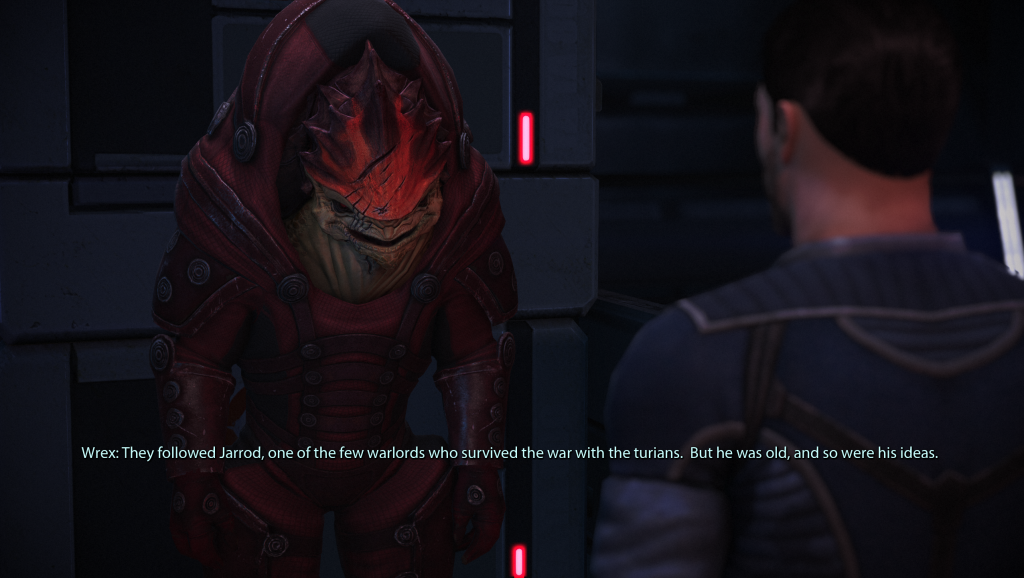
Regardless, in Mass Effect you get one of the most effective build-wide approaches to lore that’s ever been seen in a video game. Dragon Age: Origins, BioWare’s next project, would try something similar but would not be even half as effective, mainly due to its slavish love of the blood-and-shit “mature fantasy” aesthetic that had suddenly come into vogue keeping it tethered to a Germanic, George RR Martin-aping backwater of the greater setting. It goes tall on Ferelden, but Ferelden sucks, and future games will explicate just how much it sucks and does not matter to the greater lore of the setting. Mass Effect gives you the whole meal. In fairness, it’s easier to do so conceptually in sci-fi than it is in fantasy — not because of lightspeed travel or teleporters or other nakedly technological conveniences, but because of liberalism.
In Mass Effect, it is literally and textually the case that you can imagine the end of the galaxy via the cyclically apocalyptic Reapers before you can imagine the end of liberal market capitalism. The Council that rules the Milky Way is constituted under easily-assumed multicultural, liberal social values that are familiar to the game’s audience, and likewise, a quite brutal free market economy that trivially favors the rich and powerful. This is not challenged at all across the series to any great degree or effect, but certainly not in the first game; perhaps the biggest economic discussion that happens at all revolves around how slavery fits into the equation, as it is a protected cultural Batarian practice. And this is mainly the fodder of random ambient dialogue and entries in your codex. Politics, as far as Mass Effect is concerned, is settled. You live at the end of history. The Reapers will see to that.
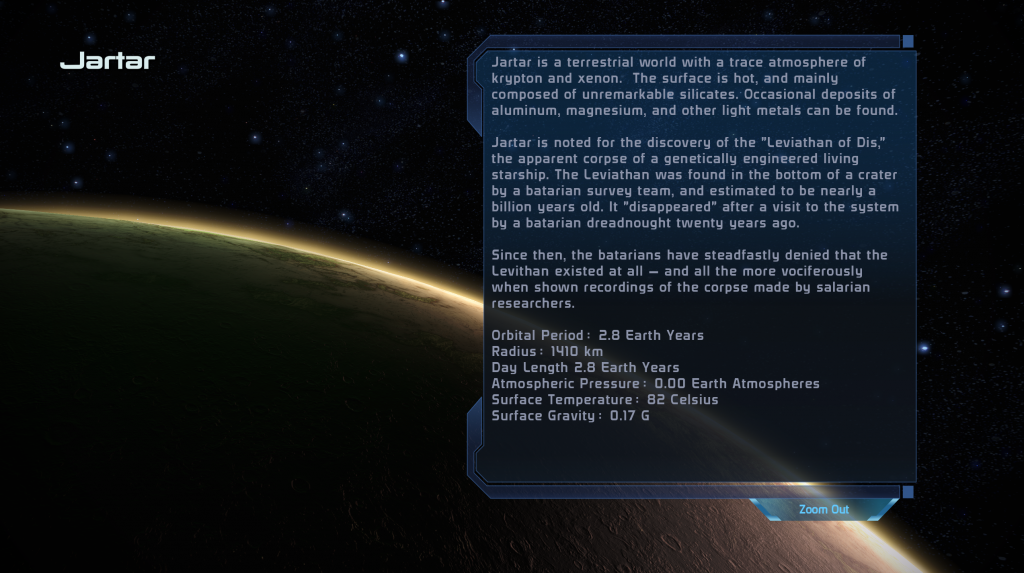
Freed from having to spend the majority of your lore-time explicating and engaging in palace intrigues and explaining evermore baroque forms of monarchy — Dragon Age has a lot of this — you can very quickly, faithfully, and memorably establish your key players, both in terms of characters and races, and have them relate to each other entirely within the assumed fictive framework without any real conflict outside of the social. That isn’t to say there isn’t some very real conflict within that framework: two of the most compelling series-long plotlines, the fates of the krogan and the geth, involve genocide and the moral ramifications of aiding it, simply allowing it, or actively opposing it. It is simply the case that because all the important questions of political economy are already decided, every conflict you encounter in Mass Effect will essentially be one of manners, even if those manners mean the difference between survival and extinction for a species. This is actually quite the selling point for a game whose nuance and player interaction is based around short snippets you select from a dialogue wheel. No one really wants to see what would happen if you were permitted to win the power to change class relations in any of these games anyhow; after all, every last one of them is written by liberals.
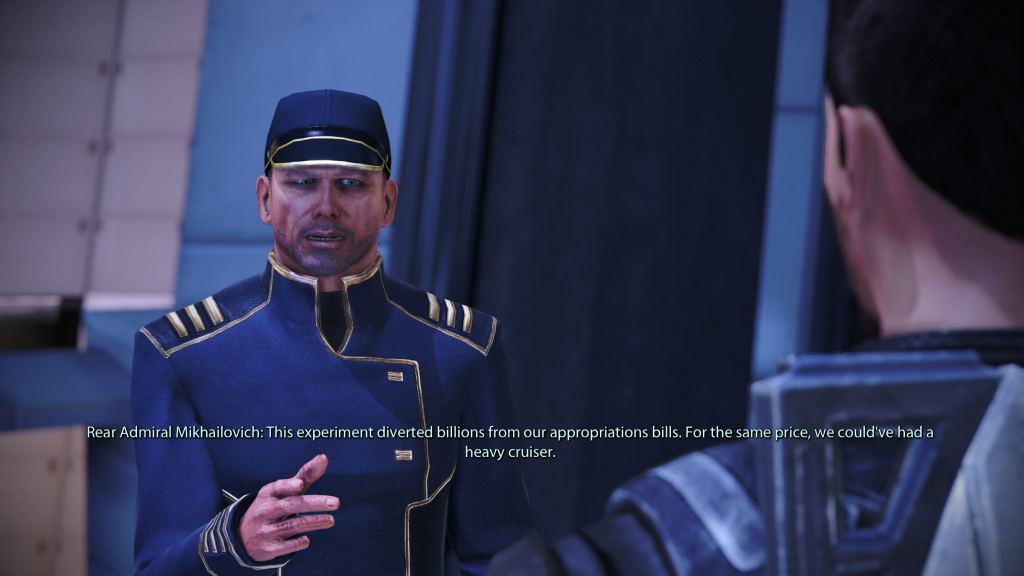
One thing you might notice if you’ve played basically any other CRPG is how quickly Mass Effect gets rolling — it’s kind of a genre conceit that these things take a long time to reach critical velocity, and the fantasy companion series Dragon Age more or less adheres to this, with Dragon Age: Inquisition in particular taking some 8-10 hours before the “real” game opens up. Mass Effect on the other hand practically motors through the Eden Prime tutorial world, cutscene-warps you back to the Citadel (to the extent that any of the Mass Effect games are hub-based, the great ancient space station and current seat of galactic government known as the Citadel is the main hub), and then you’re given a single main quest: to provide evidence the game’s villain, Saren, has betrayed the Council that gave him the power to ignore all laws to enforce their will, and thereby get him thrown out of the Special Tactics and Reconaissance (Spectre) program and have yourself inducted in his stead. What follows is a whirlwind 30 minutes or so where the evidence you need just happens to be on the station within a couple floors of the Council chamber, and also just so happens to introduce you to three of the game’s four remaining party members. Given that Mass Effect has six party members total, you get fully half of them in this one quest that also aligns you with your goal for the rest of the game. At this point you’re two, maybe three hours if you’ve really stopped to sidequest; if you’re keeping it moving, you can be named the first human Spectre within an hour or so. And then the real meat of the game, with all the different alien worlds to visit, opens up.
Most of those worlds are really empty when it comes to shining cities or great cultural sites! Mass Effect doesn’t really have alternate hubs or “homeworld” areas for lore purposes so much as it has remote base camps and secret corporate labs hidden in mountains you need to access with a floaty rover. The lore will build mainly through social interactions with your shipmates and wandering around the galaxy filling out your codex; again, while it forms a very wide base of lore for you to learn, the parts of the galaxy you’ll actually be seeing are the dangerous, grimey ones filled with killers. Later games will get into what e.g. the Asari and Krogan homeworlds are like. You’ll, ah, get to see the Turian homeworld eventually, at least from a distance. There’s a sense of remoteness and loneliness as you explore the galaxy that really complements the hustle and bustle of the Citadel — and it IS very hustling and bustling by 2007 standards, even if it is playing some elevator and corridor loading tricks to the absolute hilt — and which is also underlined by the very sparse, soft-toned soundtrack, which in later games would get switched out for heavy action synths in Mass Effect 2 and the sort of Tragedy Piano that was coming into vogue in sad scenes by the time of Mass Effect 3.

It’s an absolute shame there aren’t more of these games; not more Mass Effect titles though that’s true too given the bum rap Andromeda got, but more relationship-focused character action games. It seems that all the impulses for character attachment have been funnelled into MOBAs and tweener character shooters like Overwatch, while all the mechanical complexity has been directed towards perfectly smooth and clean loot loops like in Destiny. Indeed, BioWare tried to thread the needle by pivoting to doing “a BioWare game” but as a Destiny-like loot shooter, and it was an utter disaster — the sort of disaster that might get a studio shuttered if it couldn’t turn around a greatest hits compilation as quickly as BioWare managed this one. Maybe at some point games like Mass Effect will come back. Maybe the Reapers will come back first.
Final Verdict:
This is the best version of Mass Effect you’re probably going to get (until the next rerelease anyway; popular games will be remastered pretty much until the industry collapses at this point) and if you haven’t played it before, somehow, this is the version to start with. Don’t worry if it feels a bit weird though; the next game will be a lot more modern, and you can definitely just skip to Mass Effect 2 if the CRPG temperament of the game doesn’t hit right for you. The import recap comic that lets you set all the major decisions from Mass Effect is included at the beginning of the second game in this collection as well. The bundle is $60 on Origin.
Have any questions or feedback? Drop us a note in the comments below or email us at contact@goonhammer.com.
